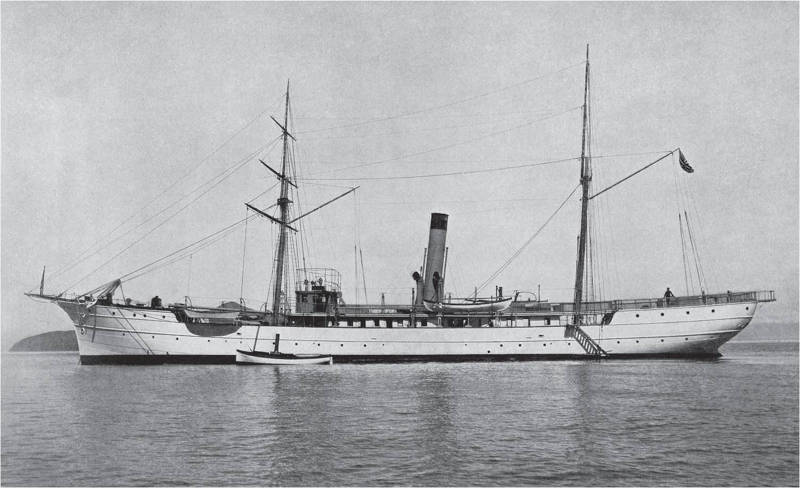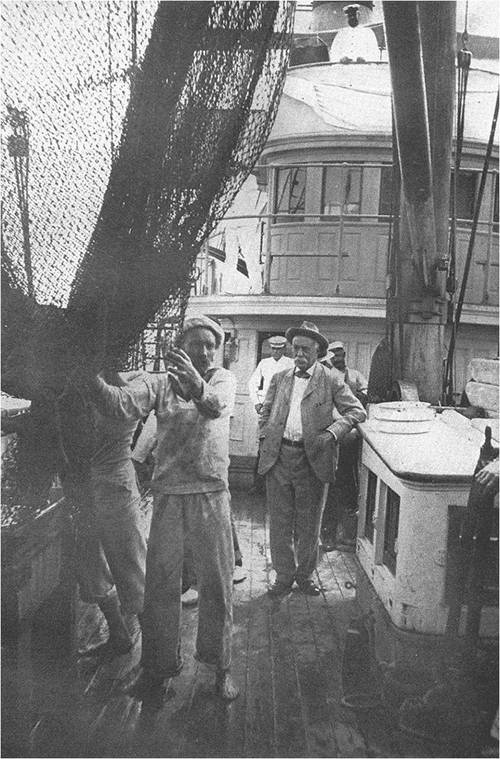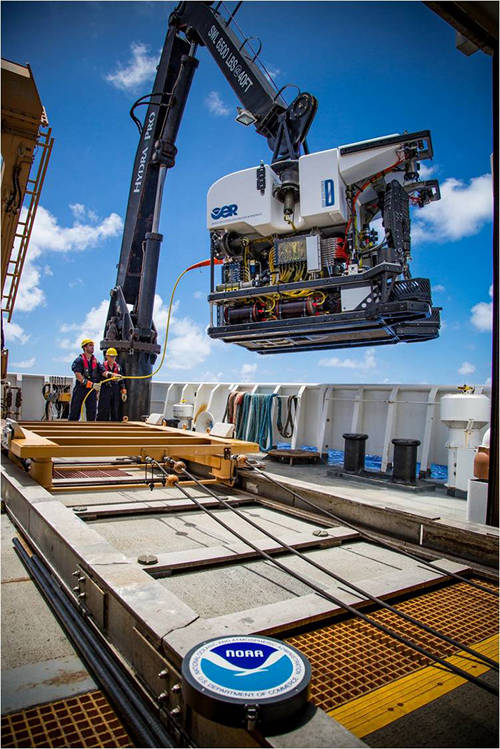
By Daniel Wagner, Ph.D. - NOAA Papahānaumokuākea Marine National Monument
August 18, 2015

The U.S. Fish Commission Steamer Albatross prior to its voyage to Hawaii and the Northwestern Hawaiian Islands in 1902. Image courtesy of the U.S. Fish Commission Archives. Download larger version (jpg, 306 KB).
The current expedition aboard NOAA Ship Okeanos Explorer has been particularly exciting because it has provided the first images of many deep-water environments in the Northwestern Hawaiian Islands. While the manned submersibles and remotely operated vehicles operated by the Hawaii Undersea Research Laboratory (HURL) have collected deep-water images in the region for the last 30 years, these have all been limited to depths shallower than 2,000 meters, as this is the maximum operating depth of HURL’s deep-sea vehicles. As a result, prior to this expedition, there were no images available for depths below 2,000 meters.
The only information we had of depths below 2,000 meters in the Northwestern Hawaiian Islands was derived from surveys performed by the research vessel Albatross over 100 years ago. The Albatross was 234-foot-long steamer operated by the U.S. Fish Commission that is considered to be the world’s first large deep-sea research vessel. The vessel was constructed in direct response to declining fisheries in many locations off the continental United States, and its objective was to find new fishing grounds to supply American markets.

The back deck of the Albatross after a collection of specimens via deep-sea trawling. Image courtesy of the U.S. Fish Commission Archives. Download larger version (jpg, 316 KB).
The steamer contained a freshwater distilling plant which allowed for prolonged deployments at sea and was equipped with a pair of powerful dredging engines carrying over 8,000 meters of steel rope, which allowed for the collection of samples to depths approaching 5,500 meters.
In 1902, the Albatross sailed to the Hawaiian Islands where the ship collected deep-sea specimens via dredging and trawling. The Albatross spent five months in Hawaii, during which a total of 344 trawls or dredges were performed, including numerous deep-sea collections in the Northwestern Hawaiian Islands at depths ranging from just a few meters down to depths approaching 3,000 meters. Hundreds of new species were subsequently described from these trawled specimens, all of which were deposited in the National Museum of Natural History, Smithsonian Institution.

NOAA Ship Okeanos Explorer docked at Pearl Harbor prior to the 22-day expedition to the Northwestern Hawaiian Islands. Image courtesy of the NOAA Office of Ocean Exploration and Research, 2015 Hohonu Moana. Download larger version (jpg, 447 KB).
Over 100 years after the Albatross explored the deep-sea in the Northwestern Hawaiian Islands, we are now returning to these remote waters aboard NOAA Ship Okeanos Explorer. While the technologies have changed dramatically since the days of the Albatross, the potential for new discoveries remains the same, as the deep-sea in Northwestern Hawaiian Islands has only marginally been explored.
Additionally, as a result of the advanced technologies and capabilities of the Okeanos Explorer, we have the opportunity to investigate scientific questions in much more detail than was possible in 1902. The high-definition cameras of the Okeanos Explorer’s underwater vehicles allows us to see what deep-sea organisms look like in their natural environments. This information is particularly useful when differentiating amongst species, as many characteristics are lost in the preservation process. Many of the specimens that were collected by the Albatross, particularly fragile organisms like corals and sponges, were damaged as a result of being trawled or dredged from the seafloor.

The remotely operated vehicle Deep Discoverer being brought back on deck of the Okeanos Explorer after a successful dive in the Northwestern Hawaiian Islands. Image courtesy of the NOAA Office of Ocean Exploration and Research, 2015 Hohonu Moana. Download larger version (jpg, 333 KB).
Furthermore, we now have accurate depth and position data for all of the observations made by the Okeanos Explorer’s underwater vehicles, which provides useful information on the ranges of deep-water fauna. In contrast, the specimens collected by the Albatross were collected by deep-water dredges and trawls, and therefore it is impossible to determine the exact location of where they were collected.
Finally, as a result of the Okeanos Explorer’s telepresence capability, onboard scientists now can benefit from the cumulative knowledge of a much broader group of scientists from around the world, who can guide investigations remotely in real time.
As a result of these technological advances, our expedition aboard the Okeanos Explorer has the potential to match the great wealth of scientific discoveries that resulted from the early voyages to the Northwestern Hawaiian Islands by the Albatross over 100 years ago.